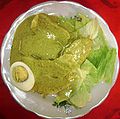This article needs additional citations for verification .(August 2012) |
| Tagetes minuta | |
|---|---|
 | |
| Scientific classification | |
| Kingdom: | Plantae |
| Clade: | Tracheophytes |
| Clade: | Angiosperms |
| Clade: | Eudicots |
| Clade: | Asterids |
| Order: | Asterales |
| Family: | Asteraceae |
| Genus: | Tagetes |
| Species: | T. minuta |
| Binomial name | |
| Tagetes minuta | |
| Synonyms [1] | |
| |
Tagetes minuta is a tall upright marigold plant from the genus Tagetes , with small flowers, native to the southern half of South America. [2] Since Spanish colonization, it has been introduced around the world, and has become naturalized in Europe, Asia, Australasia, North America, and Africa. [2] Tagetes minuta has numerous local names that vary by region. In the Andes it is known as Huacatay or Wacatay, and in other regions it is common as chinchilla, chiquilla, chilca, zuico, suico, or anisillo. [3] Other names include Muster John Henry, [4] southern marigold, [5] khakibos, stinking roger, [6] wild marigold, [2] and black mint. It is called the Quechua terms huacatay in Peru [7] or wakataya in Bolivia. [8]
Contents
It is used as a culinary herb in Peru, Ecuador, and parts of Chile and Bolivia. It is commonly sold in Latin grocery stores in a bottled, paste format as black mint paste.




